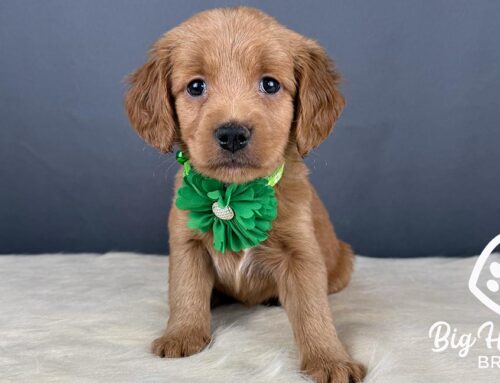What Colors Can Dogs See? The Truth Revealed
What Colors Can Dogs See? The Truth Revealed
If you’ve ever tossed your dog a bright red ball and watched them zoom past it like it’s invisible, you’ve probably asked yourself: What colors can dogs see? And no, your Mini Golden Retriever isn’t being rude; they just might not be seeing that toy the way you do.
At Big Hearted Breeders, we love diving into the quirky science behind our pups. Understanding how your dog sees the world is more than just fun trivia, it can help you choose better toys, improve training, and even strengthen your bond. So, grab a snack (maybe something not red), and let’s find out: what colors can dogs see, and what does their version of the world really look like?
 Wait… Can Dogs Even See Color?
Wait… Can Dogs Even See Color?
Yes! Despite the myth that dogs only see in black and white (thanks, 1950s textbooks), dogs are not stuck in a monochrome movie. However, their version of color vision differs from ours.
Humans have three types of color-detecting cells in our eyes, called cones. These let us see the whole rainbow, from vibrant reds and oranges to purples and pinks. Dogs, however, only have two types of cones. This means they see a limited color spectrum—think of it like the world through a slightly outdated Instagram filter.
So, what colors can dogs see?
Mainly shades of blue and yellow. Reds and greens? Not so much. In fact, red likely appears as a dark gray or brown, and green might look yellowish.
How Dogs See the World (And Why It’s Still Awesome)
 Picture this: you’re holding up a bright orange tennis ball and waving it in front of your Mini Golden. You’re thinking, “How could they NOT see this?” But to your dog, that orange ball blends into the grass like camouflage. It’s basically a game of “Where’s Waldo,” but with fewer stripes and more slobber.
Picture this: you’re holding up a bright orange tennis ball and waving it in front of your Mini Golden. You’re thinking, “How could they NOT see this?” But to your dog, that orange ball blends into the grass like camouflage. It’s basically a game of “Where’s Waldo,” but with fewer stripes and more slobber.
So when you ask, what colors can dogs see, imagine their world like this:
- Blue = blue
- Yellow = yellow
- Red = probably dark brown or gray
- Green = yellow-ish gray
- Purple = might look blue
- Orange = brownish or dull yellow
Dogs are basically rocking that “vintage filter” life—and somehow, still happier than most of us.
But Why Does It Matter?
Knowing what colors dogs can see actually comes in handy. Here’s how:
 1. Toy Shopping
1. Toy Shopping
That neon pink squeaky donut might look adorable to you, but your pup likely sees it as a dull brown circle. If you want your dog to actually see the toy (not just sniff it out), go for blue or yellow.
2. Training Tools
If you use colored training props, keep them high-contrast. A yellow clicker on a dark mat? Great. A red target on green grass? That’s basically invisible.
3. Agility & Enrichment
Many agility courses are designed with this in mind—using blue and yellow markers to make them more dog-vision friendly. So yes, agility dogs have color-coordinated equipment. Fancy!
A Bit of Eye Science (Without Getting Boring, Promise)
 We touched on cones earlier, but let’s go a little deeper—because hey, science is cool when it explains why your dog can’t find their red Kong.
We touched on cones earlier, but let’s go a little deeper—because hey, science is cool when it explains why your dog can’t find their red Kong.
Dogs have:
- 2 types of cones (humans have 3)
- More rods (which help them see in low light)
- Better motion detection
So while your pup doesn’t get the whole color party you do, they absolutely destroy you in night vision and motion sensing. If you’ve ever watched your dog spot a squirrel 100 feet away at dusk, you’ve seen this in action.
In short, what colors dogs can see is only part of the story. Their eyes are built for survival, not sunsets.
Myth Buster: Are Dogs Colorblind?
Technically, yes—but not in the way you might think.
“Colorblind” doesn’t mean “no color.” It just means “limited color perception.” In humans, this condition is known as red-green color blindness. Dogs have a similar visual condition, but it’s natural, not a defect.
So yes, what colors dogs can see is limited—but they’re not stuck in black and white. That old myth needs to go the way of the flip phone.
What About Puppies? Do They See Color Too?

Absolutely! Puppies are born with their eyes closed and don’t fully open them until around 2 weeks old. Their vision is blurry at first, and color vision takes time to develop. But by the time your Mini Golden is bouncing around your living room, they’re seeing the world in that good ol’ yellow-and-blue spectrum.
So if you’re decorating a nursery and wondering if your pup will appreciate the pink wallpaper, probably not. But a bright yellow stuffed duck? 10/10 would chase again.
Does This Affect Dog Training?
It can! Many training tools and visual cues rely on contrast to enhance their effectiveness. So if you’re waving a red hand signal in front of a green background, your dog might not react—not because they’re ignoring you, but because they legit don’t see it.
Switch to blue or yellow for better visibility. And when in doubt, combine visual cues with sound or scent. Your dog’s nose and ears are still MVPs.
Can Dogs See TV?
Funny enough—yes. Especially modern TVs with high refresh rates. Your dog might not care about the colors on screen, but if there’s a moving squirrel? Oh, they see that.
Just remember, what colors can dogs see affects what grabs their attention. A bright red cartoon dog might not pop like it does to you, but that high-pitched bark from the speakers? They’re on it.
Big Hearted Tip: Embrace the Dog View
At Big Hearted Breeders, we believe in raising well-rounded, happy, and healthy Mini Golden Retrievers. And part of that means understanding how they experience the world.
So next time you’re picking a toy, decorating a playroom, or setting up a backyard obstacle course—ask yourself: what colors can dogs see? Then grab something yellow or blue and enjoy the tail wags that follow.
Final Thoughts: What Colors Can Dogs See?

To wrap it up:
Dogs see the world in shades of yellow and blue.
They don’t see red or green the way we do, but they more than make up for it with motion detection, night vision, and pure enthusiasm.
So the next time your pup ignores a red toy or chases a yellow tennis ball like it’s the Holy Grail, remember—they’re not colorblind. They’re just color-different. And honestly? They’re doing just fine with the view they’ve got.
Now, excuse us while we go toss a yellow squeaky duck across the yard for the fifteenth time today.
FAQ: What Colors Can Dogs See?
Can dogs see red?
Not really. Red appears as a dark gray or brown and often blends into the green of grass or the dark flooring.
Why do dogs like yellow toys so much?
Yellow is one of the most apparent colors in their vision. It stands out against many backgrounds, making it easier to chase and find.
Are blue toys suitable for dogs?
Yes! Blue is another color that dogs can see clearly. That’s why many dog training tools are blue or yellow.
Can dogs see in the dark better than humans?
Absolutely. Dogs have more rods in their eyes, which makes them better at seeing in low light. Their night vision is way better than ours.
Do all dog breeds see the same colors?
Yes—while breeds may vary in size and snoring volume, their color vision is the same across the board: two cones, yellow-blue vision.
Big Hearted Breeders – Where science meets wagging tails, and every day looks bright, even in dog-vision blue and yellow.





